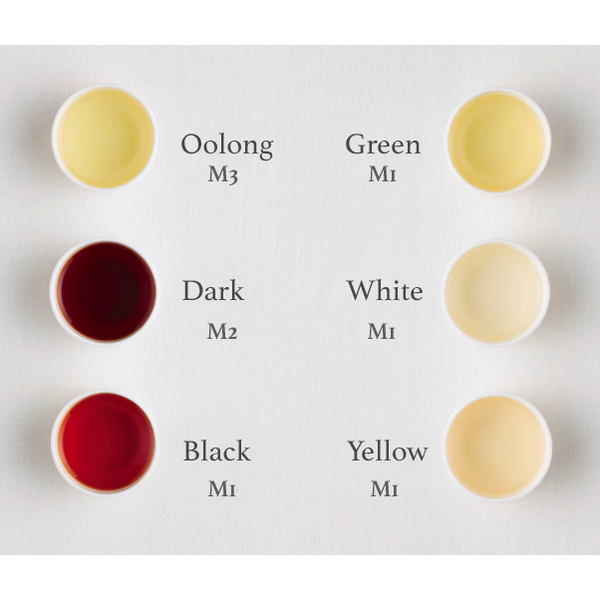
What is cupping?
Cupping is a term that describes the process of professional tea evaluation.
During this process, every tea is examined on 1. physical appearance of its dry leaf 2. Internal characteristics of the tea when brewed.
Typically, a cupping process goes something like this*:
- Sampling
To judge any given tea correctly and fairly, a representative amount and quality of tea sample need to taken out from the original packaging for evaluation.
Because tea leaves come in different shapes and sizes, larger whole leaves tend to stay on top while smaller fragments settle at the bottom.
It’s important to make sure all the layers (top, middle and bottom) of the tea are taken in sampling to ensure consistency.
The samples are then placed on an evaluation plate and rotated to even-out the tea samples for evaluation.
How to even out tea sample on plate
- Dry Leaf
When judging the quality of dry leaf, the shape, colour, consistency and purity of the tea are graded respectively by visual examination.
So, it’s important to carry out the Cupping process in a well lit room or next to window (usually North facing).
When it comes to judging single origin teas from China and Japan, each tea has a well defined shape that they must conform when crafted properly.

For example, Tieguanyin (Iron Goddess) tea, a type of Oolong made in China, should always have ball shape with the higher quality Tieguanyin leaves having greater degree of tight-wrapped, weighted leaves compared to lower grades.
Accordingly, each of the four criteria above is graded by inspection to give an overall score for the dry leaf.
- Cupping
The most crucial part of the process is to correctly prepare the tea for judging its aroma and taste.
Each type of tea (Black, Oolong, Yellow, Green, White, and Dark) has its own desired preparation methods, which the evaluator must follow.

6 types of tea and their typical brewing methods*:
M1: Cupping Set, Sample: 3g, Water: 150ml, Infusion Time: 5min
M2: Cupping Set, Sample: 5g, Water: 200-250ml, Infusion Time: 8-10min
M3: Gaiwan, Sample: 5g, Water: 110ml, Infusion Times: 2, 3, and 5min (3 infusions)
- Aroma (Hot)
When the tea is brewed, the first step of grading is the evaluation of its aroma released from the hot infusion.
Evaluator uses one hand to hold the cup, and the other hand to lift the lid with a slight opening to allow aroma to diffuse. Allowing the aroma to be inhaled through nose for 2-3 seconds, then immediately close the lid.
For Gaiwan, first lift the lid up vertically and bring the lid up close to the nose in clockwise motion with the underside the lid facing up towards the face.
This is because aroma compounds present in Oolong teas tend to accumulate underneath the lid in gaiwan. Regardless for cupping set or gaiwan method, it is important to make sure not to breath into the vessel to avoid dissipating the aroma.
Note in Japan, the evaluation of green teas are carried out using a tea strainer placed inside a bowl, and aroma evaluated through lifting the strainer containing the leaf up close to the nose.
Like judging the dry leaf of a tea, every handcrafted tea has a desire set of aroma profiles that evaluators look for. These aroma characteristics can be very specific, and requires significant tasting experience. However, the typical aroma profiles of the major six tea types (Black, Oolong, Yellow, Green, White, and Dark) are generally well distinguished from each other and can be found here.
- Liquor Colour
After removing the tea leaves and pouring out the tea infusion into the bowl, the tea liquor can be checked for its colour, clarity, and brightness.
Generally, the liquor colour appears darker as the oxidation takes its course - from non-oxidised green tea the lightest to fully oxidised black tea having more brownish red colour.
- Aroma (Warm)
At this point, evaluators can take another sniff of the aroma coming off from the infusion and the wet leaf. The temperature of leaf and the aroma released is lower compared to just brewed, so it is a good evaluation point for the characteristic of aroma.
The best temperature to take note of the aroma is said to be when wet leaf is at around 55 degree Celsius.
- Liquor Taste
The most anticipated step of sipping comes only after aroma is being judged.
There is a plethora of unique tastes when it comes to single origin teas - with each tea cultivar presenting a unique set of tastes that is different from another.
Unlike blended teas, single origin teas have unique taste purely based on their cultivar itself not by adding other tastes, and is further enhanced (or diminished in unfortunate cases..) by craft.
This is why grading teas of the same cultivar requires more skill and experience as the differences are subtle and evaluators really need to know the processing behind the specific tea to associate the resulting taste with its quality.
Even among the most experienced tea tasters, there are particular areas of expertise he or she is good at, and others not so familiar due to the extremely broad range of teas available worldwide.
Ultimately, grading tea is just the starting point to understand tea producers’ craft and produce, and puts tea taster in a unique position to exchange ideas with the producers.
- Aroma (Ambient)
When the tea is cooled to ambient temp. the residue aroma it releases is good indicator of how much lingering/length of the aroma there is for the tea, which is another criteria for grading the tea.
- Wet leaf
Reading the tea leaves in the cupping process is the last step that reveals surprisingly a lot about the tea being judged (it doesn’t tell you the fortunes, however…!)
Tea leaves are very ‘honest’ and visual checks on the shape, consistency, purity of tea leaves can tell you what cultivar the tea is made of, the grade/season of tea you just tasted - very important when you are blind tasting a series of different teas.
For semi-oxidised Oolongs, reddish brown areas on each leaf represents how much oxidation it had taken place during the processing, and reveal if the withering process had been done to the desired effect.
*Note: a typical process used in evaluation of teas in China. Process differs slightly in other parts of world.




